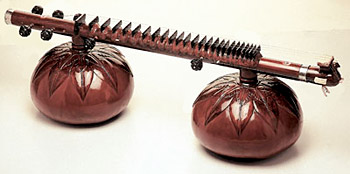 Melody Instruments used in Indian Classical Music are those instruments which are primarily used for a solo instrumental performance. During earlier times, the voice was held to be the primary vehicle of classical music. If an instrument were used to accompany the voice, it was deemed a secondary instrument and the player hence lost the social prestige of a soloist. The rise of instrumental music in the modern eras was a rather slow and gradual process.
Melody Instruments used in Indian Classical Music are those instruments which are primarily used for a solo instrumental performance. During earlier times, the voice was held to be the primary vehicle of classical music. If an instrument were used to accompany the voice, it was deemed a secondary instrument and the player hence lost the social prestige of a soloist. The rise of instrumental music in the modern eras was a rather slow and gradual process.
Since Mughal times (the sixteenth through the nineteenth centuries), chordophones have been the primary instruments of classical music. In ancient times, Veenas in great variety were described. However, most of these were harps and lyres. The Rudra Veena is a stick-zither, which dominated the Mughal period and persisted through the twentieth century. Now called the Bin, the Rudra Veena is fading fast from modern performances. It became so highly treasured, and players of it so specialized, that teachers became protective of its technique and learning, and would teach it only to family members.
Though the Sitar and Sarod have held a pre-eminent position in the instrumental tradition by virtue of their versatility and inheritance of the Dhrupad instrumental techniques of the older Veena and Rebab, other players have brought different instruments to the classical stage in the latter part of the twentieth century.
 The Santoor is a hammered dulcimer of a type found in the West and all along the Silk Road into China. In India, Kashmir is its home, but it is now played throughout the North. Initially, it would seem unlikely that such an instrument would be accepted as classical, since a hammered dulcimer, with its fixed-string arrangement, is incapable of slides and certain types of ornaments. Indeed, older players scoffed when it was first presented on the classical stage. But what it has lacked in these dimensions its players have made up for by using variation in dynamics, speed, and rhythmic excitement, which, by the end of the twentieth century, has given the Indian Santoor players a large following around the world.
The Santoor is a hammered dulcimer of a type found in the West and all along the Silk Road into China. In India, Kashmir is its home, but it is now played throughout the North. Initially, it would seem unlikely that such an instrument would be accepted as classical, since a hammered dulcimer, with its fixed-string arrangement, is incapable of slides and certain types of ornaments. Indeed, older players scoffed when it was first presented on the classical stage. But what it has lacked in these dimensions its players have made up for by using variation in dynamics, speed, and rhythmic excitement, which, by the end of the twentieth century, has given the Indian Santoor players a large following around the world.
Instruments as yet thought of as suitable only for folk airs now play the Raaga and Tala of the classical tradition with subtlety and virtuosity. These include the double-reed Shehnai and the transverse flute, the Bansuri, which are both keyless aerophones whose holes are stopped directly with the fingers. The players must master difficult whole- and half-hole fingerings to execute the microtones and slides. It is only in the last sixty years or so that instrumentalists have shown that these instruments are capable of the range of expression heretofore thought of only as in the realm of the classical players.
Another instrument which has gained popularity as a solo instrument is the harmonium. The predecessor of the Harmonium was brought to India by the Christian missionaries and before long, it was made into a small wooden instrument with the bellows pumped with one hand while the player, seated cross-legged on the floor, played the keyboard with the other. It was ideal for leading the group singing of hymns and Bhajans, because it was loud enough to keep a group of singers on pitch. It was decried in classical circles because of its tempered tuning which was viewed as damaging to the music. As time went on, though, it became more and more accepted as a classical instrument to accompany voice and one occasionally even hears a harmonium solo.




















